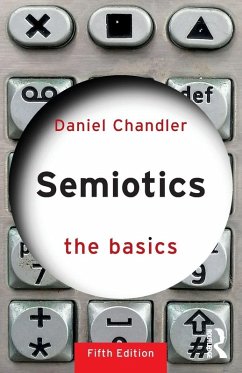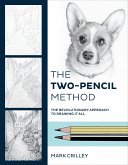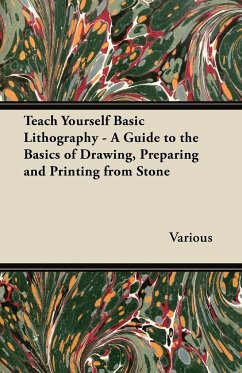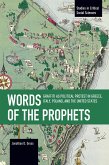- Broschiertes Buch
- Merkliste
- Auf die Merkliste
- Bewerten Bewerten
- Teilen
- Produkt teilen
- Produkterinnerung
- Produkterinnerung
This fifth edition of the bestselling textbook is a major new revision, continuing to provide a concise introduction to the key concepts of semiotics in accessible and jargon-free language. A must-have guide for students of language, communication, media, and cultural studies at both undergraduate and postgraduate levels.
Andere Kunden interessierten sich auch für
![The Two-Pencil Method: The Revolutionary Approach to Drawing It All The Two-Pencil Method: The Revolutionary Approach to Drawing It All]() Mark CrilleyThe Two-Pencil Method: The Revolutionary Approach to Drawing It All23,99 €
Mark CrilleyThe Two-Pencil Method: The Revolutionary Approach to Drawing It All23,99 €![Ship Models Ship Models]() Simon StephensShip Models38,99 €
Simon StephensShip Models38,99 €![Encountering the Past within the Present Encountering the Past within the Present]() Siobhan KattagoEncountering the Past within the Present52,99 €
Siobhan KattagoEncountering the Past within the Present52,99 €![Teach Yourself Basic Lithography - A Guide to the Basics of Drawing, Preparing and Printing from Stone Teach Yourself Basic Lithography - A Guide to the Basics of Drawing, Preparing and Printing from Stone]() VariousTeach Yourself Basic Lithography - A Guide to the Basics of Drawing, Preparing and Printing from Stone27,99 €
VariousTeach Yourself Basic Lithography - A Guide to the Basics of Drawing, Preparing and Printing from Stone27,99 €![Words of the Prophets Words of the Prophets]() Jonathan GrossWords of the Prophets31,99 €
Jonathan GrossWords of the Prophets31,99 €![Social Memory and Heritage Tourism Methodologies Social Memory and Heritage Tourism Methodologies]() Social Memory and Heritage Tourism Methodologies60,99 €
Social Memory and Heritage Tourism Methodologies60,99 €![ECO ART INCUBATOR CYPRUS ECO ART INCUBATOR CYPRUS]() Nancy HolmesECO ART INCUBATOR CYPRUS29,99 €
Nancy HolmesECO ART INCUBATOR CYPRUS29,99 €-
-
-
This fifth edition of the bestselling textbook is a major new revision, continuing to provide a concise introduction to the key concepts of semiotics in accessible and jargon-free language. A must-have guide for students of language, communication, media, and cultural studies at both undergraduate and postgraduate levels.
Produktdetails
- Produktdetails
- The Basics
- Verlag: Taylor & Francis Ltd
- 5 ed
- Seitenzahl: 398
- Erscheinungstermin: 8. August 2025
- Englisch
- Abmessung: 198mm x 129mm x 22mm
- Gewicht: 436g
- ISBN-13: 9781041016113
- ISBN-10: 1041016115
- Artikelnr.: 73329667
- Herstellerkennzeichnung
- Libri GmbH
- Europaallee 1
- 36244 Bad Hersfeld
- gpsr@libri.de
- The Basics
- Verlag: Taylor & Francis Ltd
- 5 ed
- Seitenzahl: 398
- Erscheinungstermin: 8. August 2025
- Englisch
- Abmessung: 198mm x 129mm x 22mm
- Gewicht: 436g
- ISBN-13: 9781041016113
- ISBN-10: 1041016115
- Artikelnr.: 73329667
- Herstellerkennzeichnung
- Libri GmbH
- Europaallee 1
- 36244 Bad Hersfeld
- gpsr@libri.de
Daniel Chandler is an emeritus faculty member at Aberystwyth University, UK, and a consultant in marketing semiotics. He is also the senior compiler of A Dictionary of Media and Communication (3rd edition, Oxford University Press, 2020) and A Dictionary of Social Media (Oxford University Press, 2016).
List of illustrations
Preface
Acknowledgements
Introduction
Definitions
Relation to philosophy and linguistics
Structuralism
Why study semiotics?
1 Models
The semiotic triangle
Natural vs. conventional signs
The Saussurean model
The arbitrariness of the linguistic sign
The relational system
The Peircean model
Jakobson's model
Sign relations
Symbolic relations
Iconic relations
Indexical relations
The case of photography
Mixed modes
Types and tokens
Rematerializing the sign
Hjelmslev's model
Reflections
Further reading
2 Realities
Categorization
Language, thought, and reality
Referentiality
Referentiality
Modality
The sign is not the thing
Empty signifiers
Reflections
Further reading
3 Structures
Horizontal and vertical axes
The paradigmatic dimension
The commutation test
Oppositions
Markedness
Deconstruction
Conceptual alignment
The semiotic square
The syntagmatic dimension
Spatial relations
Sequential relations
Structural reduction
Langue and parole
Reflections
Further reading
4 Codes
The language model
Digital and analogue codes
Typologies
Social codes
Textual codes
Genre
Aesthetic realisms
Invisible editing
Interpretive codes
Ways of reading
Codification
Limitations
Reflections
Further reading
5 Ways of meaning
Rhetorical tropes
Metaphor
Metonymy
Synecdoche
Irony
Master tropes
Denotation and connotation
Myth
Reflections
Further reading
6 Interactions
Models of communication
Context and relevance
Communicative functions
The positioning of the subject
Modes of address
Intertextuality
Problematizing authorship
No text is an island
Intratextuality
Textual framing
Reflections
Further reading
7 Perspectives
Structuralist semiotics
Poststructuralist semiotics
The return of Saussure
Social semiotics
Cognitive semiotics
Cartesian dualism
Semiotic stances
Mental representation
Embodiment
Methodologies
An ecological and multimodal approach
Reflections
Further reading
Going further
Glossary
References
Index
Preface
Acknowledgements
Introduction
Definitions
Relation to philosophy and linguistics
Structuralism
Why study semiotics?
1 Models
The semiotic triangle
Natural vs. conventional signs
The Saussurean model
The arbitrariness of the linguistic sign
The relational system
The Peircean model
Jakobson's model
Sign relations
Symbolic relations
Iconic relations
Indexical relations
The case of photography
Mixed modes
Types and tokens
Rematerializing the sign
Hjelmslev's model
Reflections
Further reading
2 Realities
Categorization
Language, thought, and reality
Referentiality
Referentiality
Modality
The sign is not the thing
Empty signifiers
Reflections
Further reading
3 Structures
Horizontal and vertical axes
The paradigmatic dimension
The commutation test
Oppositions
Markedness
Deconstruction
Conceptual alignment
The semiotic square
The syntagmatic dimension
Spatial relations
Sequential relations
Structural reduction
Langue and parole
Reflections
Further reading
4 Codes
The language model
Digital and analogue codes
Typologies
Social codes
Textual codes
Genre
Aesthetic realisms
Invisible editing
Interpretive codes
Ways of reading
Codification
Limitations
Reflections
Further reading
5 Ways of meaning
Rhetorical tropes
Metaphor
Metonymy
Synecdoche
Irony
Master tropes
Denotation and connotation
Myth
Reflections
Further reading
6 Interactions
Models of communication
Context and relevance
Communicative functions
The positioning of the subject
Modes of address
Intertextuality
Problematizing authorship
No text is an island
Intratextuality
Textual framing
Reflections
Further reading
7 Perspectives
Structuralist semiotics
Poststructuralist semiotics
The return of Saussure
Social semiotics
Cognitive semiotics
Cartesian dualism
Semiotic stances
Mental representation
Embodiment
Methodologies
An ecological and multimodal approach
Reflections
Further reading
Going further
Glossary
References
Index
List of illustrations
Preface
Acknowledgements
Introduction
Definitions
Relation to philosophy and linguistics
Structuralism
Why study semiotics?
1 Models
The semiotic triangle
Natural vs. conventional signs
The Saussurean model
The arbitrariness of the linguistic sign
The relational system
The Peircean model
Jakobson's model
Sign relations
Symbolic relations
Iconic relations
Indexical relations
The case of photography
Mixed modes
Types and tokens
Rematerializing the sign
Hjelmslev's model
Reflections
Further reading
2 Realities
Categorization
Language, thought, and reality
Referentiality
Referentiality
Modality
The sign is not the thing
Empty signifiers
Reflections
Further reading
3 Structures
Horizontal and vertical axes
The paradigmatic dimension
The commutation test
Oppositions
Markedness
Deconstruction
Conceptual alignment
The semiotic square
The syntagmatic dimension
Spatial relations
Sequential relations
Structural reduction
Langue and parole
Reflections
Further reading
4 Codes
The language model
Digital and analogue codes
Typologies
Social codes
Textual codes
Genre
Aesthetic realisms
Invisible editing
Interpretive codes
Ways of reading
Codification
Limitations
Reflections
Further reading
5 Ways of meaning
Rhetorical tropes
Metaphor
Metonymy
Synecdoche
Irony
Master tropes
Denotation and connotation
Myth
Reflections
Further reading
6 Interactions
Models of communication
Context and relevance
Communicative functions
The positioning of the subject
Modes of address
Intertextuality
Problematizing authorship
No text is an island
Intratextuality
Textual framing
Reflections
Further reading
7 Perspectives
Structuralist semiotics
Poststructuralist semiotics
The return of Saussure
Social semiotics
Cognitive semiotics
Cartesian dualism
Semiotic stances
Mental representation
Embodiment
Methodologies
An ecological and multimodal approach
Reflections
Further reading
Going further
Glossary
References
Index
Preface
Acknowledgements
Introduction
Definitions
Relation to philosophy and linguistics
Structuralism
Why study semiotics?
1 Models
The semiotic triangle
Natural vs. conventional signs
The Saussurean model
The arbitrariness of the linguistic sign
The relational system
The Peircean model
Jakobson's model
Sign relations
Symbolic relations
Iconic relations
Indexical relations
The case of photography
Mixed modes
Types and tokens
Rematerializing the sign
Hjelmslev's model
Reflections
Further reading
2 Realities
Categorization
Language, thought, and reality
Referentiality
Referentiality
Modality
The sign is not the thing
Empty signifiers
Reflections
Further reading
3 Structures
Horizontal and vertical axes
The paradigmatic dimension
The commutation test
Oppositions
Markedness
Deconstruction
Conceptual alignment
The semiotic square
The syntagmatic dimension
Spatial relations
Sequential relations
Structural reduction
Langue and parole
Reflections
Further reading
4 Codes
The language model
Digital and analogue codes
Typologies
Social codes
Textual codes
Genre
Aesthetic realisms
Invisible editing
Interpretive codes
Ways of reading
Codification
Limitations
Reflections
Further reading
5 Ways of meaning
Rhetorical tropes
Metaphor
Metonymy
Synecdoche
Irony
Master tropes
Denotation and connotation
Myth
Reflections
Further reading
6 Interactions
Models of communication
Context and relevance
Communicative functions
The positioning of the subject
Modes of address
Intertextuality
Problematizing authorship
No text is an island
Intratextuality
Textual framing
Reflections
Further reading
7 Perspectives
Structuralist semiotics
Poststructuralist semiotics
The return of Saussure
Social semiotics
Cognitive semiotics
Cartesian dualism
Semiotic stances
Mental representation
Embodiment
Methodologies
An ecological and multimodal approach
Reflections
Further reading
Going further
Glossary
References
Index








